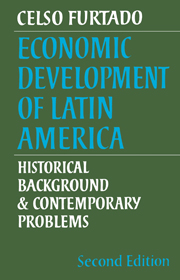Book contents
- Frontmatter
- Contents
- Tables
- Preface to the second edition
- Preface to the first edition
- Abbreviations
- Maps
- PART ONE FROM THE CONQUEST TO THE FORMATION OF NATION-STATES
- PART TWO ENTRY INTO THE SYSTEM OF INTERNATIONAL DIVISION OF LABOUR
- PART THREE THE TRADITIONAL STRUCTURAL PATTERN
- PART FOUR CHARACTERISTICS OF THE INDUSTRIALISATION PROCESS
- PART FIVE REORIENTATION OF DEVELOPMENT IN THE RECENT PERIOD
- PART SIX INTERNATIONAL RELATIONS
- PART SEVEN INTRA-REGIONAL RELATIONS
- PART EIGHT STRUCTURAL RECONSTRUCTION POLICIES
- 22 Economic planning experiments
- 23 Agrarian reforms
- 24 Economic aspects of the Cuban Revolution
- 25 Present problems and prospects
- Bibliography
- Index
25 - Present problems and prospects
Published online by Cambridge University Press: 25 January 2010
- Frontmatter
- Contents
- Tables
- Preface to the second edition
- Preface to the first edition
- Abbreviations
- Maps
- PART ONE FROM THE CONQUEST TO THE FORMATION OF NATION-STATES
- PART TWO ENTRY INTO THE SYSTEM OF INTERNATIONAL DIVISION OF LABOUR
- PART THREE THE TRADITIONAL STRUCTURAL PATTERN
- PART FOUR CHARACTERISTICS OF THE INDUSTRIALISATION PROCESS
- PART FIVE REORIENTATION OF DEVELOPMENT IN THE RECENT PERIOD
- PART SIX INTERNATIONAL RELATIONS
- PART SEVEN INTRA-REGIONAL RELATIONS
- PART EIGHT STRUCTURAL RECONSTRUCTION POLICIES
- 22 Economic planning experiments
- 23 Agrarian reforms
- 24 Economic aspects of the Cuban Revolution
- 25 Present problems and prospects
- Bibliography
- Index
Summary
After a century and a half of separation from their former European metropolises, the Latin American countries still present, jointly or severally, a profile not yet fully delineated. Each sub-region is at a different stage of a process of cultural homogenisation, of social and political modernisation and of an economic process that is in many respects sui generis. The institutions that formed the substratum of colonial society - the hacienda, the dependent indigenous community and the agricultural enterprise producing for export - remained virtually intact in the period that followed and provided the foundation for the formation of the nation-states. Economic development, insignificant in the three preceding centuries, gained momentum in the mid-nineteenth century, with the entry of the region into the system of international division of labour that emerged from the Industrial Revolution. Up to the beginning of the present century this development consisted in making extensive use of available land and labour resources for the purpose of specialising in the export of primary products. In many cases this required substantial infrastructural investment, generally financed abroad. Thus, the penetration of modern technology favoured the infrastructure rather than the directly productive activities.
Modernisation of infrastructures provided agglomeration economies favouring the urban populations, which began to increase in the last quarter of the nineteenth century as a reflexion of the expanding external sector and the final consolidation of the nation-states. With urbanisation, the transplanting of private and public consumption standards from countries with an industrial-based civilisation was intensified.
- Type
- Chapter
- Information
- Economic Development of Latin AmericaHistorical Background and Contemporary Problems, pp. 296 - 304Publisher: Cambridge University PressPrint publication year: 1977



